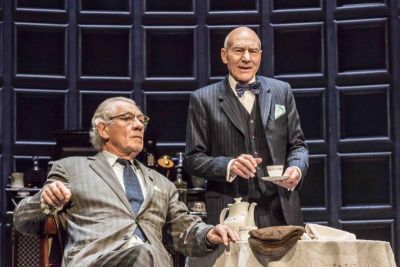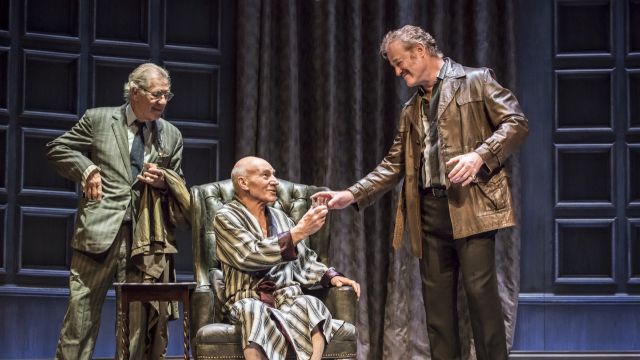No Man’s Land
One of the great pleasures of this National Theatre Live production is to see Pinter’s poetic, enigmatic, multi-layered text in the hands of two old pros: Patrick Stewart as ‘Hirst’ and In McKellan as ‘Spooner’. They have, moreover, honed their roles, first in New York and then on tour in the UK before landing at Wyndham’s Theatre. It was the site, after the premiere at the Old Vic, of the famed 1975 production with Gielgud and Richardson. Are Stewart and McKellan as good? It doesn’t matter. Mr Stewart plays Hirst as a literary man once successful and still wealthy, but losing his grip on reality. He is blank and bewildered, fall-down drunk, has short term memory loss, but can still bounce back hail and hearty… before falling again into a trough of despair… or into ‘no man’s land… where it is always dark and silent…’
Mr McKellan’s Spooner, the literary failure, is on the make – throughout the play, actually – verbose, garrulous, wheedling, but on figuring he has the upper hand, sly, patronising… Then the Pinter-esque reversal: frightened, confused… then again, seeing his chance, opportunistic – desperately so. The barriers to Spooner’s hastily assembled agenda are Hirst’s minders: Foster (Damien Molony) is a good-looking young thug who turns out to have his own literary pretensions, and Briggs (Owen Teal), a stolid older fellow, perhaps a former criminal, with a Mexican moustache. Whether or not these two are a gay couple is left open – but they are a co-dependent team and both these actors are very good. Why they are there in Mr Hirst’s house becomes clear; but how they got in, in the first place, remains a disturbing mystery.
It’s hard to say how much detail the live audience in Wyndham’s Theatre can see, but designer Stephen Brimson Lewis’ costumes are nicely indicative of character. The wardrobe is quite deliberately 70s. Foster, for instance, appears in flares, a tight bomber jacket and Cuban heels. Mr Brimson Lewis first introduces a groomed if near comatose Hirst in casual but very expensive jacket and slacks, while Spooner has a corrugated cap, a grubby, shapeless old suit – lining protruding from the sleeves - filthy sandshoes and a CND badge. The set design is similarly pointed and – if you like – thematic. The living room of Hirst’s Hampstead pile is circular, enclosing and grey, like the inside of a tomb – although with wind-tossed branches projected above. So there is a world outside... In the second act, someone opens the curtains… but they are quickly shut again. Darkness is better.
 But then there is the play itself. Since 1975 critics, reviewers and audiences have enjoyed the show, but confessed to not really understanding it, not quite getting ‘the point’ or what it’s really ‘about’. The show certainly is enjoyable – delightfully verbally dextrous, playful, funny and abruptly switching direction from pathos to menace to comedy and back again. But complex though it may be in its themes and its treatment or creation of character, milieu and background, it has familiar Pinter tropes, so to speak. There is the intruder – albeit on the back foot – who disturbs the status quo; there is the constant struggle or competition for dominance (among males), confessional speeches that are more revealing than the speaker intends, and the abrupt switches from comedy to menace, to the threat of violence. Here the comedy can spring from the abrupt and surprising switches of tone. Or it can be Pinter playing with an extended riff. At the start of the second act, Hirst returns, having left the stage an utterly pathetic figure. He claims not to recognise Spooner, the man he invited there the night before, but he and Spooner engage in a sort of game in which it seems – but is it true? – that they were at Oxford together and poached each other’s lovers and, true or not (probably not), there is real dismay and gleeful triumph at the revelations. It is almost a set piece, but a brilliant sketch on two fellows still competing in sexual fantasies that can still shock and hurt.
But then there is the play itself. Since 1975 critics, reviewers and audiences have enjoyed the show, but confessed to not really understanding it, not quite getting ‘the point’ or what it’s really ‘about’. The show certainly is enjoyable – delightfully verbally dextrous, playful, funny and abruptly switching direction from pathos to menace to comedy and back again. But complex though it may be in its themes and its treatment or creation of character, milieu and background, it has familiar Pinter tropes, so to speak. There is the intruder – albeit on the back foot – who disturbs the status quo; there is the constant struggle or competition for dominance (among males), confessional speeches that are more revealing than the speaker intends, and the abrupt switches from comedy to menace, to the threat of violence. Here the comedy can spring from the abrupt and surprising switches of tone. Or it can be Pinter playing with an extended riff. At the start of the second act, Hirst returns, having left the stage an utterly pathetic figure. He claims not to recognise Spooner, the man he invited there the night before, but he and Spooner engage in a sort of game in which it seems – but is it true? – that they were at Oxford together and poached each other’s lovers and, true or not (probably not), there is real dismay and gleeful triumph at the revelations. It is almost a set piece, but a brilliant sketch on two fellows still competing in sexual fantasies that can still shock and hurt.
That said, a reservation I have about this production is that director Sean Mathias may have leaned rather too far towards comedy at the expense of menace. Is it all a little softer than Pinter may have intended? When Foster and Briggs burst in – and who the hell are these fellows – it’s more a frisson than a chill down the spine. More clowns than bovver boys.
 Nevertheless, the spine of the piece is there. In the Q&A attached to the end of the show, with all four cast and the director on stage, the moderator asks if Hirst’s mansion, embodied by Mr Brimson Lewis’ set, is an ‘antechamber to death’ and is that is the ‘no man’s land’ of the title and the meaning of the play. I was relieved to hear the now venerable Mr McKellan say, with a chuckle, ‘No, no, it’s about free food and booze.’
Nevertheless, the spine of the piece is there. In the Q&A attached to the end of the show, with all four cast and the director on stage, the moderator asks if Hirst’s mansion, embodied by Mr Brimson Lewis’ set, is an ‘antechamber to death’ and is that is the ‘no man’s land’ of the title and the meaning of the play. I was relieved to hear the now venerable Mr McKellan say, with a chuckle, ‘No, no, it’s about free food and booze.’
You might say that that is to simplify to an absurd extent, but really free food and booze and the lengths to which Spooner, Foster and Briggs will go to get or keep them is the driving narrative force. Spooner, on the skids, sees with the failing Hirst the possibility of a comfy berth (no matter how he dresses it up), and Foster and Briggs, already on a good thing, don’t want Spooner buggering things up (no matter how they dress it up). It is in fact on this solid and perfectly understandable basis that Pinter and this great cast can take off, play, reveal, shock and surprise. It is a situation, which develops to an inconclusive conclusion, but the conclusion is there, unavoidable, for all of them and it is death. This is Pinter at the height of his powers, weaving his own personal obsessions into a struggle for survival. As Hirst says, several times, ‘I’ll drink to that.’
Michael Brindley
Images: Ian McKellen, Patrick Stewart and Owen Teale; Ian McKellen and Patrick Stewart & Ian McKellen, Damien Molony, Owen Teale and Patrick Stewart in No Man's Land. Photo by Johan Persson
Subscribe to our E-Newsletter, buy our latest print edition or find a Performing Arts book at Book Nook.

